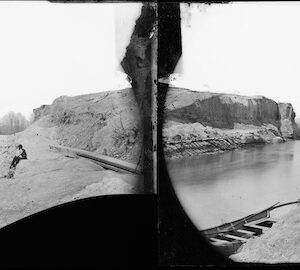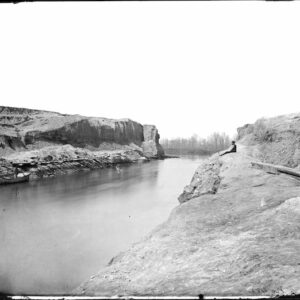| Credit: | by Reekie (John) |
|---|---|
| Date: | 1865.03 |
| Negative Size: | 8 in. x 10 in. |
| Equipment: | oar |
| Locations & Lines: | Dutch Gap Canal VA; James River; Virginia |
| Military Units: | US Army |
| Transports: | rowboat |
| Sources: | Library of Congress; National Archives |
$6.99
File Details: AIMOm, 750 DPI, TIFF, Copy Negative, 41.9 Mb
Image ID: AIMO
Gardners Photographic Sketch Book Of The War. Vol. 2, No. 87. Dutch Gap Canal, James River, Virginia. March, 1864 [sic].
The Dutch Gap Canal was cut across a narrow neck of land on the James River, eight miles in a direct line from Richmond. The object of this work was to save about seven miles of river navigation, by uniting two different points of the river, which here made a great bend, flowing around a bluff, and forming an isthmus of only five hundred feet wide. The work of excavation was commenced on the 9th of August, 1864. The rebels opened their formidable batteries on the laborers, on the 13th, and with few intervals maintained a fire from mortars and rifled guns until the conclusion of the enterprise. The regiments employed on the work were the 116th and 169th New York volunteers, and the 4th, 6th, 10th, 36th, 38th, and 100th United States colored regiments. From the commencement of the work, the labors of these troops averaged one hundred twenty men for a period of ten hours each day, working eighteen days in August, twenty-five days in September, and twenty-six days in October. From the first of November until the time of completion, the average consisted of one hundred and thirty men, working eleven and a half hours each day. On the 8th of December the middle dam or partition holding back the water from the portion excavated by manual labor, and the use of carts, was blown out, five hundred pounds of powder being used. At this time fifteen feet of water was admitted into the entire Canal, except that portion at the upper end, comprising about fifty feet, remaining to be excavated, On the night of the 30th of December the mines were laid under the bulkhead, which divided the water in the Canal from the river above, and on the afternoon of the 1st of January were exploded in the presence of Major General Butler and Staff, General Ludlow, who had charge of the work, General Collis, and Senator Clarke, of New Hampshire. The chief correspondent of the New York Herald, who also witnessed the affair, says in his account: The result of the explosion was hardly what was expected of it. The mass of dirt was heaved up by the powder but fell back substantially in the same position. A crater was formed, into which the water ran slowly from the Canal below. This extended about two thirds of the distance from the head of the water in the Canal to the edge of the water in the James. No connection between the Canal and the River was established. Since that time, however, the Canal has been opened, and a few vessels of light draught have ventured through. The entire length of the Canal is five hundred and twenty-two feet, and the greatest width at the top of the excavation one hundred and twenty-two feet. The bed of the Canal is sixty feet wide,and at high water sixteen feet deep, except at the upper end, where it is still obstructed to a considerable degree by the dirt which fell back after the explosion.
Etched onto negative: 939


